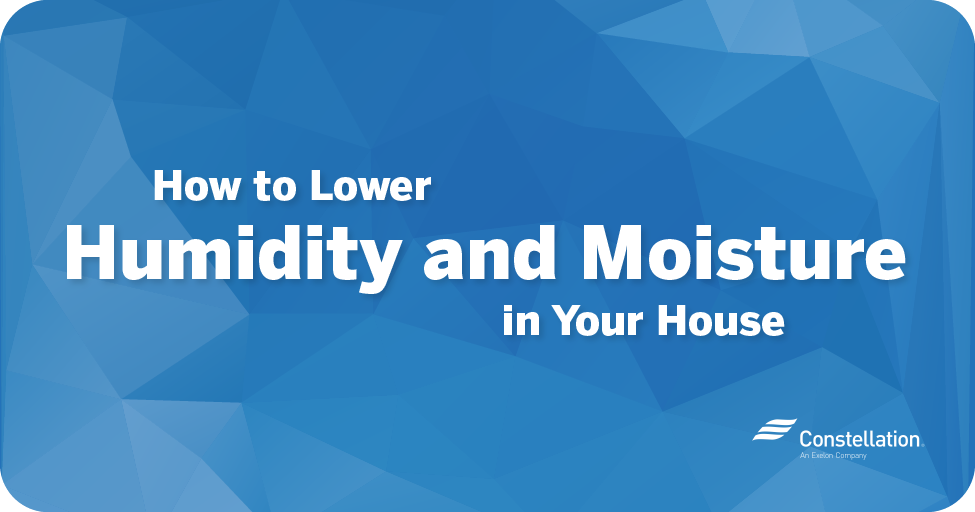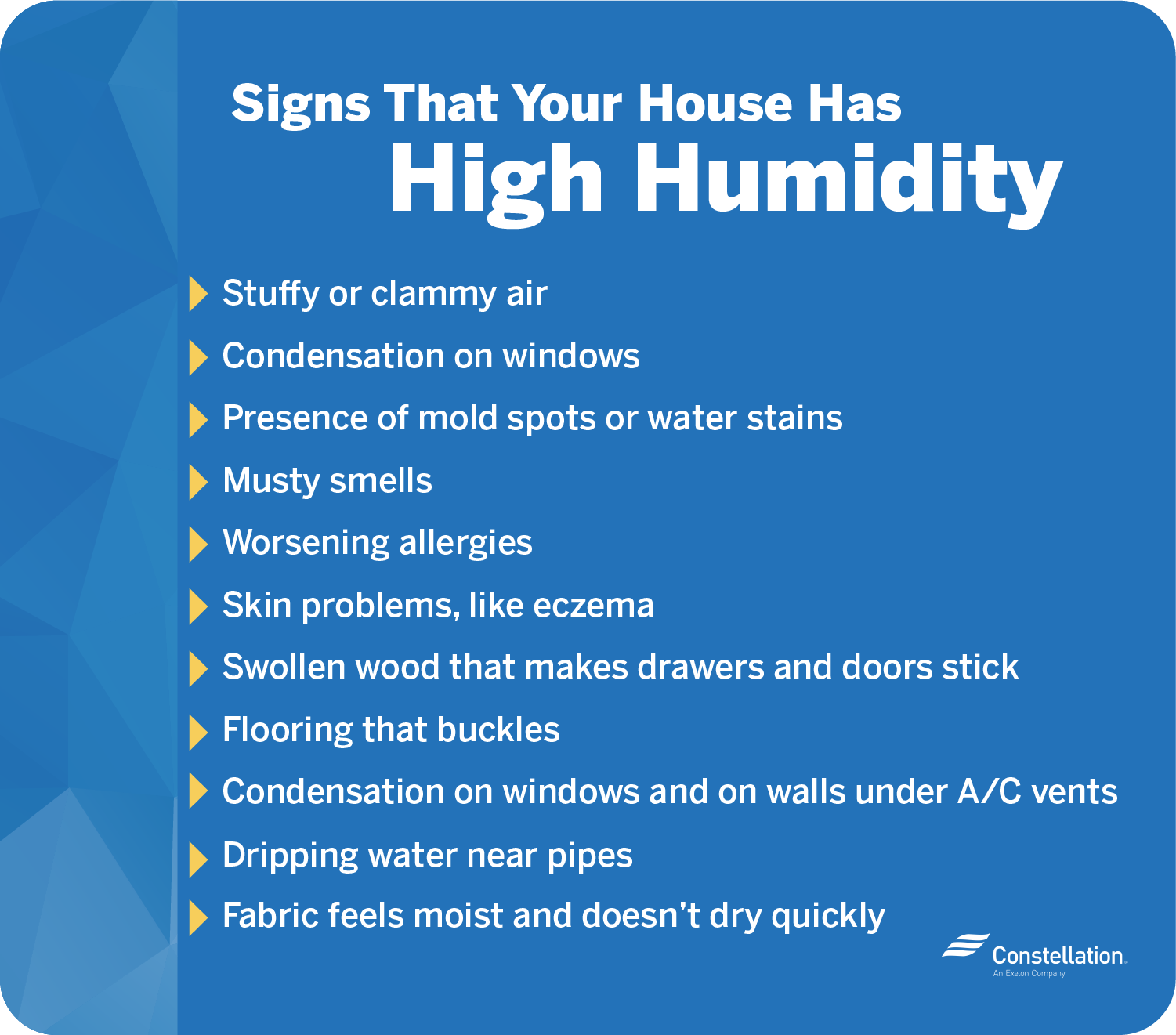
- Category:
Home Energy Savings -
Last updated:
June 20, 2022
How to Lower Humidity and Moisture in Your Home
It’s important to know how to lower humidity in your home. Too much moisture in the air is more than just uncomfortable — it can cause health problems and lead to costly water damage.
The ideal humidity range is 30%–50%. If it’s higher, you’ll feel hot and sticky. High humidity provides an ideal environment for mold and mildew that can damage your health and the surfaces they grow on. Wood can swell, making doors and windows hard to close. Left unchecked, wet wood can deteriorate and attract destructive insects. Metal surfaces will pit and rust. Everything from clothes, drapes, rugs and pets may take on an unpleasant smell.
It’s definitely in your interest to make sure the humidity in your home is at the right level so you can avoid any of these problems. Keep reading to learn more about what causes high humidity and how you can control it.
7 ways to get rid of moisture in the home
To control moisture in the home, you need to address the ways it gets in as well as what’s preventing it from venting out.

1. Repair any water leaks and cracks in walls.
When considering what causes high humidity in a house, water leaks are a big contributor. They can occur when cracks in walls let groundwater or rainwater seep in. Another example is when pipes slowly leak moisture into the material around them. That water then evaporates and becomes vapor in your home, causing water damage and promoting mold and bacteria as it does so.
Find and repair leaks as quickly as possible.
2. Invest in a dehumidifier.
A dehumidifier is a device that pulls water out of the air, helping you maintain a lower humidity level. You can find one in every price range. To reduce power consumption, look for an energy-efficient dehumidifier that’s certified by ENERGY STAR ®️.
Some people use humidifiers in the summer to feel cooler. But if you already have high humidity, these devices can make it worse.
3. Run your exhaust fans whenever possible.
Most homes have exhaust fans in places where moisture tends to build up. Fans can vent steam over the stove from boiling water or in the bathroom from a hot shower. Be sure to run them while cooking and showering — and for several minutes after finishing to make sure the steam is dissipated.
These devices are a great option for how to reduce humidity in your house, and using energy-efficient fans whenever possible can reduce the amount of electricity you use as well.
4. Maintain your AC filter.
The filters on your AC units are meant to capture dirt, dust, pet dander and debris that float in the air and reduce air quality. When these filters get clogged, they also trap moisture, becoming a water wick that creates a perfect environment in which mold and bacteria can thrive. It won’t take long for you to start seeing signs of high humidity in your home.
New filters are more likely to work as designed, so try to replace them regularly. It’ll go a long way toward keeping your indoor air clean and not too humid.
5. Grow or purchase plants that absorb humidity.
Plants can improve indoor air quality as well as add beauty to your rooms. Some of them are natural dehumidifiers, efficiently drawing moisture out of the air. Here are some of the best plants for reducing the humidity in your home:
- Peace lilies
- Boston ferns
- Palms
- Orchids
- Spider plants
- Tillandsia
- Cactuses
- English ivy
6. Take cooler, shorter showers.
Hot showers fill your home with steam. You burn energy heating the water, too. Hot water feels good, but it isn’t healthy for your skin: It can cause dryness, strip off natural oils and worsen certain skin conditions.
Cooler showers will help you control moisture in your house. And if you use a low-flow shower head, you’ll also save water.
7. Improve your home’s air circulation.
Increasing air circulation in your home clears out pockets of humid, stale air and replaces it with fresh. Opening windows, using vents and running fans can make a big difference in helping you control moisture in your house. Moving air also feels cooler, which is a benefit if you have high humidity in your house in the summer.
What causes high humidity in a house?
When looking for ways to lower humidity in your house, it helps to understand what causes high humidity in a house to begin with. If you have any signs of high humidity in your home, look to these potential culprits:
- Hot, humid climates. Some homes are naturally humid because of where you live. Some regions are prone to humidity, and some homes are located in humid microclimates. If you live near a body of water, especially in valleys and near lakes and oceans, you can experience more humidity.
- Showering, washing clothes and other routine household activities. Common household activities can make it tough to control moisture in your house. Cooking, doing laundry and showering all produce steam and up the humidity in your home.
- Oversize air conditioning units. An air conditioner that’s too large cools air so fast that its cooling cycle is too short to dehumidify the air. You might think bigger is better, but not in this case. Right-sizing your unit to your space improves comfort and energy consumption.
- Cracks and leaks in and around your home. Cracks in your home and in pipes and fittings around your home can let in moisture from groundwater and rainwater. Pipe leaks are a slow-motion source of damage and humidity. As the moisture evaporates, it creates humidity and spreads mold and bacteria.
- Wrong types of plants. While certain plants pull water from the air, others add to it. If you overwater, evaporation can make your home feel like a greenhouse.
Signs that your house has high humidity
How can you tell if you have a humidity problem? What are the signs of high humidity in your home? If you experience any of the following, you may need to look for ways to control moisture in your home:

- Stuffy or clammy air
- Condensation on windows
- Presence of mold spots or water stains
- Musty smells
- Worsening allergies
- Skin problems, like eczema
- Swollen wood that makes drawers and doors stick
- Flooring that buckles
- Condensation on windows and on walls under air conditioning vents
- Mold and stains on walls and other surfaces
- Dripping water near pipes
- Fabric feels moist and doesn’t dry quickly
The importance of managing your home’s humidity
High humidity is about more than comfort. It’s important to know how to lower humidity in your house to prevent health problems and damage to your home. Be sure to keep a sharp eye out for signs of high humidity in your home and react quickly. You’ll save your home, your health and energy.




